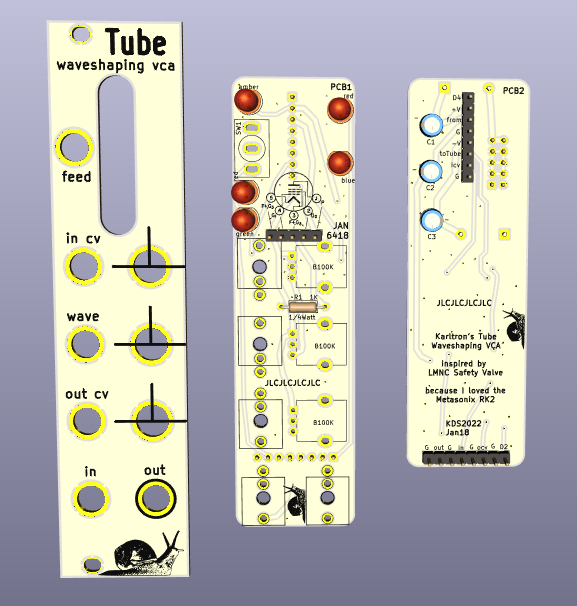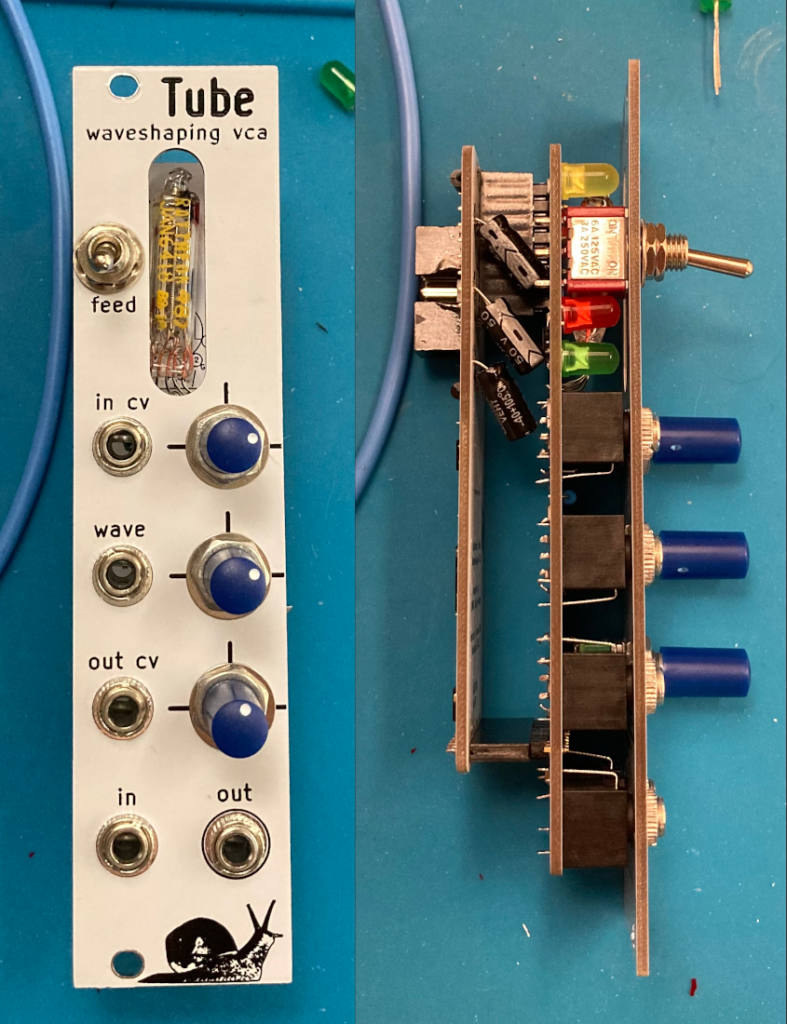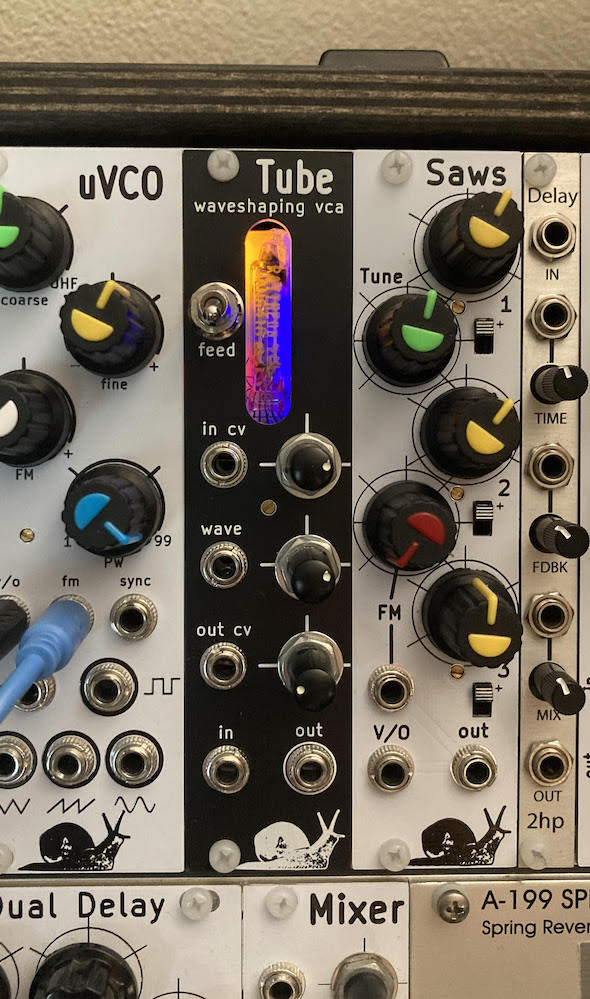Tube is a characterful VCA. A vacuum tube is like a transistor, but analog and imperfect. It can therefore be adjusted to have various tones imparted on your sound.
The Tube waveshaping VCA is a 6HP module with one channel IN/OUT, three input CV jacks with offset knobs, and a switch for activating a feedback path. If you have experience with tube VCAs elsewhere you know the sound is very dependent on the voltage level given, so this module has both a pre- and post-tube VCA to control the gain and therefore the sound.
The two VCAs are configured to have a huge range of CV, to give you maximum option for smashing your sound. When set low, it can be a very clean VCA, or when set high you have the opportunity to wavefold through extreme clipping; this module can output a 20Vpp signal.


The ‘wave’ CV sets a grid voltage that bends your waveform around a centerpoint, adding harmonics. Works best on softer sounds like a triangle, since a square doesn’t fold very interestingly.
The feedback switch optionally routes the output back into the input, running through a diode to censor some of that signal. This can phase-cancel and reduce your volume at many settings of the wave cv, but enable sweet spots with glitchy self resonance for that electric grunge sound. It can even approximate digital noise if fed high frequencies and set on a clipping threshold.
V1 is in good working order and ready to go. V1.1 fixes some tube cathode current issues we’re seeing on some natural tube variation.
It’s a tight squeeze to put a 35mm tube and three knobs on the same front panel, so I expect to use micro knobs like on NLC Clump.
| Item | Price | Note |
| PCB/Panel | $25 | Three parts: fp,p1,p2 A few smudged front panels available with $8 discount (B-Stock) |
| Tube | $6 | Jan6418, NOS Raytheon 1980’s |
| Full Parts Kit (incl above) | $100 | everything you need to build, except solder |
| Built & Tested | $155 | a module ready to use |
| Black Panel | +$20 | standard panels are white, upgrade to night mode. |

Includes SMT parts, which can be tricky to solder, not suitable for your first endeavor into DIY, take a look at the LM13700 in SOIC, it’s got 1.27mm pitch pins. I use 0805 size, which many consider pretty easy to hand solder with the right tools. You’ll want copper braid and liquid flux to clean off bridged pins, and a fine tweezers to align all the components. I like 0.5mm solder for this.
Technical Details
The tube is a Jan6418, which seems to be readily available in 2022. I learned of it after enjoying the Hackerboutique Destructo VCF. It nominally uses a 1.25V heater integrated with the cathode. I’m running it from the -12V rail with about 1500 ohms, which then sees about ten and a half volts. You can get the tube to glow if you reduce this resistor, but that will reduce the lifespan of your tube.
There’s five LEDs under the front panel, meant to shine through the tube window. An amber is meant to be always-on, and non-functional. Two red are indicative of the in/out CV levels, and a blue that indicates the wave cv level. These four are optional if you’d prefer a dark module that uses less power. The fifth LED is in the feedback path and influences the tone, it’s marked green but hardly lights up at all, since we run very little current through that section.
| Reference | Color | Voltage | Resistor | Usage |
| D1 | Amber | 12 always | 1K at R2 | non-functional |
| D2 | Red | 2.6 max | 100R at R3 | out cv level |
| D3 | Blue | 12 max | 2x10K at R4/R5 | wave cv level |
| D4 | Red | 2.6 max | 100R at R9 | in cv level |
| D5 | Green | 12 max | 10K at R7 | feedback path |
The VCAs are exponential response using a PNP 3906 feeding an LM13700, which has necessitated us to use SMT construction. The offset knobs add +/- 12V to the CV, so they can be completely muted, or adjust the baseline amplification for your envelope, or blast your signal with extreme amplification.
BOM and build guide for V1.1 is complete. This is probably what you need.
BOM and build guide PDF (for V1.0) and an ibom html for v 1.0.0. Updates here, you can get better signal by changing R6&31 to 22k or a double-stacked 47K(=23K).
Power draw is measured at 30 mA on +12 and 43mA on -12. Possibly the coolest tube module you’ll find.
V1.1 boards have a trimmer to adjust the cathode/heater voltages. The circuit has two 470 ohm resistors and a 1K trimmer, so you can adjust between 940 and 1940 ohms. The Tube is specified for a 1.2V heater voltage and we’re using -12 and restricted by the trimmer. Going below 400 ohm will burn out the tube, so be careful not to short R1. Higher than necessary resistance will reduce your signal volume. Some tubes are showing microphonic 3-4 khz ringing, try insulating the tube from loud noises. I like to put a dab of hot glue on the top after assembly to prevent it from shaking.
The trimmer when turned clockwise will increase the power to the tube, turning it on. Fully on and you have a boring clean VCA with some clipping distortion at high gain. Turning the trimmer counterclockwise turns the tube off and will reduce the volume sometimes to zero. The ideal behavior is in the middle where the signal gets analog wobbly. It’s a broad sweet spot, don’t worry about an exact precision.
Units I sell as built&tested are calibrated already, as I have a test rig for new tubes.
Troubleshooting Tips
Be sure all the chips are lined up the right direction. Pin 1 is down on this module, which means the text should be readable with the same orientation as the webpage URL. The big diodes are power blocking, so if they’re reversed there’s no power. Check the solder on the transistors, they’re very small pads and the transistors should be PNP type.